Guru Purnima
Celebrating the Guru

Hindus attach paramount importance to spiritual gurus. Gurus are often equated with God and always regarded as a link between the individual and the Immortal. Just as the moon shines by reflecting the light of the sun, and glorifies it, all disciples can dazzle like the moon by gaining from their Gurus.
What is Guru Purnima?
The full moon day in the Hindu month of Ashad (July-August) is observed as the auspicious day of Guru Purnima, a day sacred to the memory of the great sage Vyasa. All Hindus are indebted to this ancient saint who edited the four Vedas, wrote the 18 Puranas, the Mahabharata and the Srimad Bhagavata. Vyasa even taught Dattatreya, who is regarded as the Guru of Gurus.
Significance of Guru Purnima
On this day, all spiritual aspirants and devotees worship Vyasa in honor of his divine personage and all disciples perform a 'puja' of their respective spiritual preceptor or 'Gurudevs'.
This day is of deep significance to the farmers, for it heralds the setting in of the much-needed rains, as the advent of cool showers usher in fresh life in the fields. It is a good time to begin your spiritual lessons. Traditionally, spiritual seekers commence to intensify their spiritual 'sadhana' from this day.
The period 'Chaturmas' ("four months") begins from this day. In the past, wandering spiritual masters and their disciples used to settle down at a place to study and discourse on the Brahma Sutras composed by Vyasa, and engage themselves in Vedantic discussions.
The Role of the Guru
Swami Sivananda asks: "Do you realize now the sacred significance and the supreme importance of the Guru's role in the evolution of man? It was not without reason that the India of the past carefully tended and kept alive the lamp of Guru-Tattva. It is therefore not without reason that India, year after year, age after age, commemorates anew this ancient concept of the Guru, adores it and pays homage to it again and again, and thereby re-affirms its belief and allegiance to it. For, the true Indian knows that the Guru is the only guarantee for the individual to transcend the bondage of sorrow and death, and experience the Consciousness of the Reality."
At the Sivananda Ashram, Rishikesh, the Guru Purnima is celebrated every year on a grand scale.
1. All aspirants awake at Brahmamuhurta, at 4 o'clock. They meditate on the Guru and chant his prayers.
2. Later in the day, the sacred worship of the Guru's Feet is performed. Of this worship it is said in the Guru Gita:
Dhyaana moolam guror murtih;
Pooja moolam guror padam;
Mantra moolam guror vakyam;
Moksha moolam guror kripa
"The Guru's form should be meditated upon; the feet of the Guru should be worshipped; his words are to be treated as a sacred Mantra; his Grace ensures final liberation".
3. Sadhus and Sannyasins are then worshipped and fed at noon.
4. There is continuous Satsang during which discourses are held on the glory of devotion to the Guru in particular, and on spiritual topics in general.
5. Deserving aspirants are initiated into the Holy Order of Sannyas, as this is a highly auspicious occasion.
6. Devout disciples fast and spend the whole day in prayer. They also take fresh resolves for spiritual progress.
The Guru's Advice
Swami Sivananda recommends: "Wake up at Brahmamuhurta (at 4 a.m.) on this most holy day. Meditate on the lotus feet of your Guru. Mentally pray to him for his Grace, through which alone you can attain Self-realisation. Do vigorous Japa and meditate in the early morning hours.
"After bath, worship the lotus feet of your Guru, or his image or picture with flowers, fruits, incense and camphor. Fast or take only milk and fruits the whole day.
In the afternoon, sit with other devotees of your Guru and discuss with them the glories and teachings of your Guru.
"Alternatively, you may observe the vow of silence and study the books or writings of your Guru, or mentally reflect upon his teachings. Take fresh resolves on this holy day, to tread the spiritual path in accordance with the precepts of your Guru.
"At night, assemble again with other devotees, and sing the Names of the Lord and the glories of your Guru. The best form of worship of the Guru is to follow his teachings, to shine as the very embodiment of his teachings, and to propagate his glory and his message."